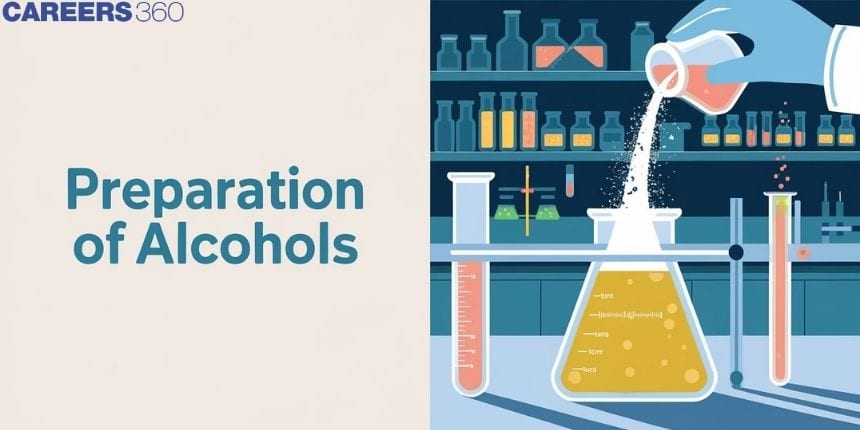Preparation of Alcohols: Different Methods and Reactions
Alcohols are compounds that have attached one or more (-OH) hydroxyl groups to them. The alcohols do not occur in the free form in nature. They are obtained from flowers, leaves, and stems of plants. Alcohols are prepared by many methods such as from the hydrolysis of halides, hydration of alkenes, Grignard reagents, etc
NEET 2025: Mock Test Series | Syllabus | High Scoring Topics | PYQs
JEE Main: Study Materials | High Scoring Topics | Preparation Guide
JEE Main: Syllabus | Sample Papers | Mock Tests | PYQs

Preparation of Alcohols
Hydrolysis of Halogens
Alkyl halides when boiled with an aqueous solution of an alkali hydroxide give alcohol through a nucleophilic substitution mechanism.
R-X + KOH → R-OH + KX
Grignard Reagent — 1: Formation
All three types of monohydric alcohols can be prepared by the use of Grignard reagents. Grignard reagents form additional compounds by nucleophile attack with aldehydes and ketones which on hydrolysis with dilute acid yields alcohol.
Mechanism


For example:![]()
Grignard Reagent - 2: Reactions
Alcohols are produced by the reaction of Grignard reagents with aldehydes and ketones. The first step of the reaction is the nucleophilic addition of Grignard reagent to the carbonyl group to form an adduct. Hydrolysis of the adduct yields alcohol.
Mechanism

Anhydrides are formed by heating of two $(-\mathrm{COOH})$ groups to remove $\left(\mathrm{H}_2 \mathrm{O}\right)$ molecule. Aldehydes, ketones, carboxylic acids, and derivatives on reduction yield alcohols. A number of reducing agents link $\mathrm{Zn} / \mathrm{HCl}, \mathrm{Na} / \mathrm{C}_2 \mathrm{H}_5 \mathrm{OH}, \mathrm{LiAlH}_4$ or NaBH4 can be used for this purpose. These derivatives are reduced by nascent hydrogen into corresponding alcohols.
Some examples include,
$\left(\mathrm{CH}_3 \mathrm{CO}\right)_2 \mathrm{O}+4 \mathrm{H} \xrightarrow[\text { ether }]{\mathrm{LiAlH}_4} \mathrm{CH}_3 \mathrm{CH}_2 \mathrm{OH}+\mathrm{CH}_3 \mathrm{COOH}$
$\mathrm{CH}_3 \mathrm{COOC}_2 \mathrm{H}_5+4 \mathrm{H} \xrightarrow[\text { or } \mathrm{LiAlH}_4]{\mathrm{Na} / \mathrm{C}_5 \mathrm{H}^2} 2 \mathrm{CH}_3 \mathrm{CH}_2 \mathrm{OH}$
LiAlH4 Reduction
NaBH4 can only reduce keto groups. But $\mathrm{LiAlH}_4$ can reduce even anhydrides and esters. $\mathrm{LiAlH}_4$ is a very good reducing agent because the (Al) atom present in ir is more covalent than the (B) atom in $\mathrm{NaBH}_4$ Therefore, Al has more tendency to gain the electrons, thus, it will try to keep the electrons to itself and hence H- will go in a particular manner. Thus, LiAlH4 is better reducing agent than $\mathrm{n} \mathrm{NaBH}_4$
Mechanism
The mechanism for LiAlH4 occurs in the following steps:
- Deprotonation

- Nucleophilic attack by the hydride ion

- Nucleophilic attack by the hydride ion

- Leaving group removal

- Alkoxide is protonated

Some examples include:


Recommended topic video on(Preparation of Alcohols)
Some Solved Examples
Example 1
Question:
Which of the following alcohols could not be synthesized by reduction of aldehyde?
1) (correct)

2)
CH3CH2OH
3)

4)

Solution:
As we learnt ,
Reduction of aldehydes yields primary alcohol while ketones are reduced to give secondary alcohols

This alcohol is secondary alcohol and can be prepared by reduction of the ketone.
Therefore, option (1) is correct.
Example 2
Question:
Which of the following compounds will most readily be dehydrated to give alkene under acidic conditions?
1) 1-Pentanol
2) 4-Hydroxypentan-2-one (correct)
3) 3-Hydroxypentan-2-one
4) 2-Hydroxycyclopentanone
Solution:
As we learned, the dehydration of alkenes involves a carbocationic intermediate. The ease of dehydration of the given compounds can be explained on the basis of the stability of the carbocation formed.
In the case of options (3) and (4), a secondary carbocation is formed, but the presence of an electron-withdrawing group adjacent to the positively charged carbon intensifies the charge and hence destabilizes the species. However, in option (2), a secondary carbocation is formed, but the electron-withdrawing group is present farther away; as a result, the effect of this group is diminished and hence the carbocation is relatively more stable. Also, the alkene produced in (3) is conjugated with the carbonyl group, which increases the product stability.
Therefore, option (2) is correct.
Example 3
Question:
The major product of the following reaction is:

1) (correct)
2)
3)
4)
Solution:
Markovnikov addition of Br+ and EtO- takes place to form the ether

Therefore, option (1) is correct.
Also Read
27 Nov'24 05:52 PM
18 Oct'24 12:43 PM
18 Oct'24 12:34 PM
18 Oct'24 12:31 PM
18 Oct'24 12:27 PM
18 Oct'24 12:19 PM
18 Oct'24 12:14 PM
18 Oct'24 12:09 PM



